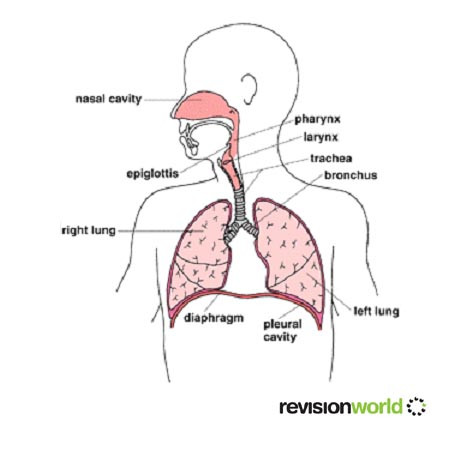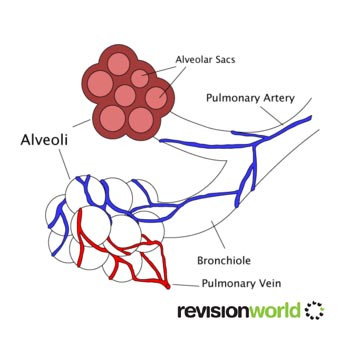Breathing
When we breathe in and out we suck air into them then expel it again.
Oxygen is absorbed from the lungs into the blood, and carbon dioxide is removed from the blood and breathed out from the lungs. This exchange is vital.

Respiratory System
Respiration is the release of energy from glucose or other organic substances. Energy is required for growth, repair, movement and other metabolic activities. There are two main types of respiration, aerobic and anaerobic.

This video explains respiration
Alveoli
Alveoli are the final branchings of the respiratory tree and act as the primary gas exchange units of the lung
Used for exchanging gases: Deoxygenated enters lungs from body, oxygenated enters capillaries from lungs
Advantages of alveoli
- Moist
- Large surface area
- Good blood supply

Aerobic Respiration
Aerobic respiration takes place in the presence of oxygen. Aerobic respiration = glucose reacts with oxygen to release energy. Carbon dioxide and water are released as waste products.
Glucose molecules react with oxygen molecules to form carbon dioxide and water molecules, with energy being released by the breaking of bonds in the glucose molecules. Our bodies require energy for the seven life processes This energy is obtained from respiration.
glucose + oxygen > water + carbon dioxide + energy .
We use the energy released from respiration for many processes. Respiration also gives off heat, which is used to maintain our high body temperature. Our rate of respiration can be estimated by measuring how much oxygen we use. During exercise, the body needs more energy and so the rate of respiration increases - The breathing rate increases to obtain extra oxygen and remove carbon dioxide from the body. The heart beats faster so that the blood can transport the oxygen and carbon dioxide faster. This is why our pulse rate increases. It is actually the build up of carbon dioxide that makes us breathe faster.
Glucose comes from our food, oxygen and from breathing
Water and carbon dioxide are exhaled
This video looks at Aerobic Respiration
Anaerobic respiration
Anaerobic respiration occurs when oxygen is not available. When not enough oxygen is available, glucose can be broken down by anaerobic respiration. This may happen during hard exercise.
Glucose is only partially broken down, and lactic acid is produced - together with a much smaller amount of energy.
Energy can still be produced without oxygen
Only a little bit of energy is obtained from respiration
glucose > lactic acid + energy
Anaerobic respiration occurs in humans when oxygen is not obtained quick enough (e.g. running fast)
Only 1/20th energy amount is produced compared to aerobic respiration
Lactic acid builds up, which causes muscle fatigue due to oxygen debt. This is overcome by deep breathing to oxidise the acid. After the exercise is finished, extra oxygen is needed by the liver to remove the lactic acid.
Being able to respire without oxygen sounds a great idea. However, there are two problems:
- Anaerobic respiration releases less than half the energy of that released by aerobic respiration.
- Anaerobic respiration produces lactic acid. Lactic acid causes muscle fatigue and pain.
This video explains Human Respiration covering Aerobic and Anaerobic respiration.
